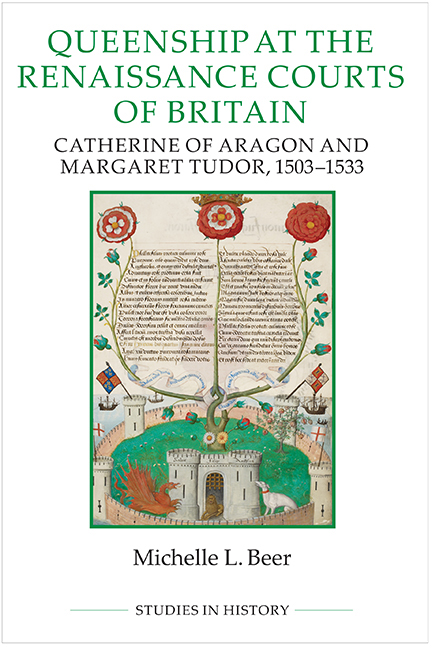Book contents
1 - Elizabeth of York
Published online by Cambridge University Press: 24 October 2019
Summary
‘[F]irst and foremost we wish and desire from our heart that we may often and speedily hear of the health and safety of your serenity, and of the health and safety of the aforesaid most illustrious Lady Catherine, whom we think of and esteem as our own daughter.’
In her letter to Isabella of Castile in 1497, Elizabeth of York took a maternal interest in the health of her future daughter-in-law, which foreshadows the close connections between these two successive queens of England. Daughter, sister, niece and wife of kings, Elizabeth of York's queenship is often dismissed as passive, and she is frequently overshadowed by her politically shrewd husband Henry vii and influential mother-in-law Margaret Beaufort. Historians of English queenship have begun to show that Elizabeth was an important, if conventional, English queen consort, who survived a politically turbulent adolescence to make a dynastically significant royal marriage and become a well-loved queen. For both Catherine and Margaret, Elizabeth of York was a profoundly important model of English queenship whose influence on the composition of the Tudor court continued after her death. Elizabeth's daughter Margaret and her successor Catherine of Aragon personally observed Elizabeth's performance of queenly duties at the Tudor court and continued to benefit from Elizabeth's familial and household connections; their relationship with Elizabeth would significantly inform their behaviour as queens.
Although Catherine, and to a lesser extent Margaret, were well-educated princesses in the academic sense, much of their understanding of how to behave and succeed as a queen consort came from observing their mothers, Isabella and Elizabeth. While Isabella of Castile undoubtedly had a profound influence on her daughter Catherine's education, for both Catherine and Margaret, Elizabeth of York offered a more direct example of what an English queen consort should be. Most elite women, including princesses, learned a great deal about their roles by observing their elders and gaining experience in a variety of court contexts. Young princesses might stand beside their mothers to greet dignitaries or ambassadors, in part to display them as prospective brides, but also to familiarise them with their future duties as queens. Both Catherine and Margaret had the opportunity watch and learn from Elizabeth of York's example before her untimely death, and their relationships with her show that the English queen cared for and watched over them both.
- Type
- Chapter
- Information
- Queenship at the Renaissance Courts of BritainCatherine of Aragon and Margaret Tudor 1503–1533, pp. 27 - 44Publisher: Boydell & BrewerPrint publication year: 2018

